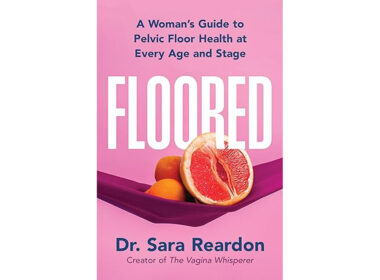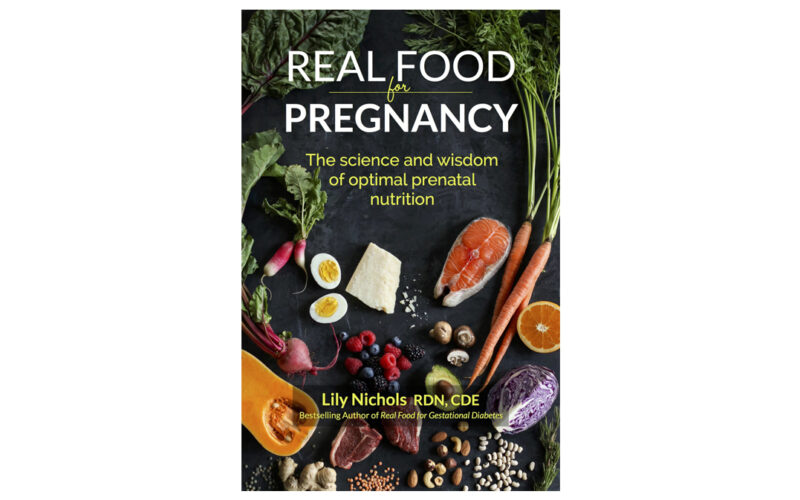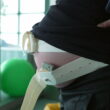Since seeing those two dark lines on a positive pregnancy test a few months ago, I’ve learned that nearly everyone has an opinion on the dos and don’ts of both prenatal and newborn care. From prenatal vitamins and exercises, to preparing for breastfeeding versus bottle feeding, to the merits of co-sleeping versus crib training, I’ve found that loved ones and strangers alike are quick to share their advice on the best practices for moms and babies.
Never is this more true than when it comes to what pregnant women eat. There are people who throw caution to the wind and proclaim, “You’re pregnant–now’s your time to eat whatever you want!” and others who warn against foods that seem totally innocuous, like pineapple, fresh mozzarella cheese, and lattes. And although this advice is usually well-intentioned, it’s clear that our culture as a whole is unsure about what types of foods support a healthy pregnancy.
One thing is clear, though: A mother’s nutrition during pregnancy has an impact on her baby’s health and development [1]. But that still doesn’t answer the burning questions: What should expectant mothers eat? And perhaps more importantly, what should they not eat? These questions have been on the minds of pregnant women for generations, and registered dietitian Lily Nichols seeks to answer them in Real Food for Pregnancy.
Lily Nichols is a Registered Dietitian/Nutritionist and Certified Diabetes Educator. She’s also the author of Real Food for Gestational Diabetes and Real Food for Fertility.
Through her background in gestational diabetes research, Nichols observed how closely linked maternal prenatal nutrition is to the health of the baby in utero. She also found that recommended conventional prenatal diets lacked key nutrients critical to both the baby’s development and a healthy pregnancy for mom. When Nichols experimented with a whole-foods approach to prenatal diet for women with gestational diabetes, the results were astounding:
“Using my real foods approach, we were able to cut in half the number of women who required insulin or medication to manage their blood sugar. We also had excellent outcomes: healthier moms who didn’t struggle with hunger or excessive weight gain; who had far lower rates of preeclampsia; and who had healthy babies who were born at a normal weight and with normal blood sugar levels.”
Real Food for Pregnancy widens Nichols’ audience beyond mothers with GD
Nichols’s findings inspired her to write her first book, Real Food for Gestational Diabetes. Its success prompted Nichols to write a nutritional guide for pregnancy that appeals to all expectant mothers, not just those with gestational diabetes. Nichols’s goal for Real Food for Pregnancy is twofold: For starters, she wants to clear up the many discrepancies surrounding optimal prenatal nutrition. Second, she wrote the book to provide an easy-to-follow guide for making the best food and lifestyle decisions during pregnancy.
Nichols says that expectant mothers who follow the conventional dietary guidelines laid out by most doctors and medical organizations are almost guaranteed to be deficient in key micro- and macro-nutrients during pregnancy, including protein, magnesium, folate, and B12.
Nichols says that expectant mothers who follow the conventional dietary guidelines laid out by most doctors and medical organizations are almost guaranteed to be deficient in key micro- and macro-nutrients during pregnancy, including protein, magnesium, folate, and B12
Nichols goes on to explain that through her research and writing, readers will learn which foods, nutrients, and lifestyle habits to embrace and why (and which ones to avoid) in order to be assured they’re doing everything within their power to have a healthy pregnancy.
Who is the intended audience of Real Food for Pregnancy?
As the title implies, Real Food for Pregnancy is intended for expectant mothers. However, some would say that the best time for women to read the material is before getting pregnant, because key nutrients like folate are most critical in the earliest stages of pregnancy before a woman may even know she is pregnant. Preconception nutrition education can help women improve their nutrient stores to ensure a healthy baby and pregnancy.
Real Food for Pregnancy is also a great read for expectant fathers. In many cases, men haven’t considered what a healthy prenatal diet consists of, so this book provides soon-to-be dads with valuable insight into how their wives can nourish their bodies during this important time. What’s more, some research suggests that Dad’s nutritional status plays a role in his offspring’s health too [2]!
What are the main content areas of Real Food for Pregnancy?
Real Food for Pregnancy is divided into twelve chapters. The first two chapters focus on the importance of eating real, minimally processed foods during pregnancy. After that, Nichols devotes four chapters to what specific foods and nutrients can help grow a healthy baby, along with examples of meal plans for an ideal day of prenatal eating. The book then focuses on common pregnancy complaints and how to remedy them through diet. In the final few chapters, Nichols shifts gears to discuss lab tests, exercising safely during pregnancy, avoiding toxins, mental health, and optimal postpartum care for mom and baby.
Nichols herself says she’s aware of the vast number of prenatal nutrition guides on the market, which made her hesitant to write another one. But the problem is, most of the nutritional information out there for expectant mothers either lacks depth, or recommends a diet plan that leaves women deficient in nutrients that are essential for a mother and growing baby, including vitamin B12, folate, and choline.
What conventional nutritional guidelines lack
In many cases, a mom will leave her first prenatal appointment with a nutrition printout that says to avoid the usual suspects: alcohol, soft cheeses, deli meats, etc., and to take a prenatal vitamin–and that’s the extent of her official prenatal dietary education. These conventional guidelines leave out valuable information that soon-to-be moms need to know when it comes to nutrition. Nichols’s main focus in Real Food for Pregnancy is to remedy this lack of prenatal diet information by giving in-depth data on how to grow a healthy baby. As opposed to many OBGYNs, Nichols’s breadth of knowledge on the topic of prenatal nutrition is hard to dispute – in fact, she provides a staggering 901 citations throughout the book.
Also unlike the conventional guidelines, Nichols’s approach to diet in Real Food for Pregnancy centers around whole foods, meaning foods in their natural state, such as fruits, veggies, meat, eggs, and minimally-processed dairy products. Whereas many nutrition guides gloss over exactly what to consume during pregnancy, Nichols stresses the importance of eating a diet rich in a variety of whole, unprocessed foods like pasture-raised eggs, wild salmon, grass-fed meat, and organic local produce.
Many dietary guidelines for pregnant women offer a laundry list of all the foods to avoid, leaving expectant mothers wondering what on earth actually is safe to eat. While there is a section of the book entitled Foods That Don’t Build a Healthy Baby in which Nichols gives evidence of the downfalls of consuming alcohol, too much caffeine, and highly processed seed oils among other foods, the bulk of the book’s content centers around what whole foods are beneficial to mom and baby, like eggs, liver, and dark leafy greens.
Strengths of Real Food for Pregnancy
What I appreciated most about Real Food for Pregnancy is the peace of mind it gave me, thanks to Nichols’s meticulous research. With the barrage of competing information on pregnancy nutrition coming at expectant mothers from social media, doctors, and well-meaning friends and family, it can be difficult to determine which recommendations are actually sound. Nichols takes the guesswork out of prenatal nutrition for her readers through her vast research and in-depth analysis. In fact, there are over thirty pages of citations at the end of the book (in small print, I might add!), making it clear that Nichols put in the hours to give the best possible recommendations to her pregnant readers.
Additionally, I liked how Real Food for Pregnancy condensed lengthy studies into language that’s easy to understand. Sometimes it’s difficult to weed through data and medical research and arrive at a solid conclusion, so I appreciated that Nichols did the work and laid out the information in a way that’s digestible for the casual reader.
Nichols offered key insights on food aversions plus cravings
On a more personal note, I appreciated Nichols’s insight on food aversions and cravings–two things I struggled with during my first trimester. Thankfully, my morning sickness wasn’t horrible, but I did have an aversion to meat and eggs–two staples of my normal diet, and my top sources of protein most days. During that first trimester, I couldn’t get enough bread and dairy, which made me feel guilty that I wasn’t nourishing the growing baby inside of me as well as I should have been.
But the book’s advice on cravings and aversions assuaged my fears: it actually told me to pay attention to them, as they could be evidence of nutrients in which my diet was lacking. The book goes on to recommend that expectant mothers struggling with food aversions and cravings simply try to eat the most nutrient-dense foods that they can stomach at that time. Reading this was a relief for me, as I was on a steady diet of sourdough toast, Greek yogurt, peanut butter and jelly sandwiches, and not much else at the time. Eventually I got past the food aversion stage–just like the book assured me I would–and I was able to more fully implement Nichols’s dietary advice knowing I did the best I could during that shaky first trimester.
…plus lifestyle recommendations and recipes
I also enjoyed the sections that Nichols included on lifestyle recommendations during pregnancy, like exercise and stress management. Nichols also included an entire section of nourishing prenatal recipes in the book, which provided some much-needed inspiration for getting out of those meal-planning ruts we all find ourselves in from time to time. A personal favorite was her bone broth recipe, which is rich in magnesium, collagen, and protein, and is perfect to have on hand to sip on as a midday snack, or to use in recipes. It’s also a great source of protein during the first trimester when your appetite might be sluggish.
Limitations of Real Food for Pregnancy
In Real Food for Pregnancy, Nichols included a section on common pregnancy complaints and how they relate to nutrition. I appreciated this section and referred to it a number of times, as I previously mentioned in regards to food aversions and cravings. My only issue is that the book didn’t address more complaints.
For instance, in my second trimester I began to have muscle problems, including leg cramps and restless legs. Of course, I was able to consult my midwife for advice, but I would have loved a section on muscle cramps in the book for more insight. Additionally, nutrition tips and information regarding headaches, swelling, and skin changes would have been helpful.
How practical are Nichols’s suggestions for the average woman?
Nichols’s main recommendation is to stick to a whole foods diet throughout pregnancy to ensure optimal nutrition for mom and baby. But with processed foods like cereals, soda, crackers, and energy bars so prevalent in the standard American diet, sometimes that can be easier said than done. Factor in food aversions and nausea during the first trimester, emotional eating during pregnancy, and overall exhaustion throughout all three trimesters, and suddenly the convenience of processed foods appears more and more appetizing.
While eating a diet of real foods like Nichols recommends can seem daunting, many women find that it becomes easier once it’s a habit. Over weeks and months of replacing processed snacks and meals with quality meat, fresh produce, and healthy grains, eating whole foods becomes easier and more enjoyable. Nichols makes the transition to real foods even easier with her meal plan recommendations and recipes in Real Food for Pregnancy.
Not to mention, a whole foods diet doesn’t have to be all or nothing. No one would blame a pregnant woman (or anyone, for that matter) for indulging in the occasional onion ring or ice cream sundae. As long as real, whole foods make up the bulk of a pregnant woman’s daily nutrients, she’s more likely to have a healthy baby.
The verdict: Buy, borrow, or skip?
My verdict on Real Food for Pregnancy?: Buy it!
The book is a must-have for any expectant mother or any woman who hopes to be pregnant in the future. Have your husband, mother, and close friends read it, too, so they can support your whole food journey during pregnancy by helping you meal plan and trying to incorporate more real foods into their diet alongside you. Nichols does an excellent job of laying out a practical, easy-to-read guide to help pregnant women nourish their bodies during a time when sound nutrition advice is most critical–for themselves and for the baby in their womb.
Additional Reading:
Natural Womanhood Reviews: Real Food for Gestational Diabetes
Natural Womanhood Reviews: Real Food for Fertility
References:
[1] Naaz A, Muneshwar KN. How Maternal Nutritional and Mental Health Affects Child Health During Pregnancy: A Narrative Review. Cureus. 2023 Nov 13;15(11):e48763. doi: 10.7759/cureus.48763. PMID: 38098932; PMCID: PMC10719542. [2] Lambrot, R., Xu, C., Saint-Phar, S. et al. Low paternal dietary folate alters the mouse sperm epigenome and is associated with negative pregnancy outcomes. Nat Commun 4, 2889 (2013). https://doi.org/10.1038/ncomms3889






